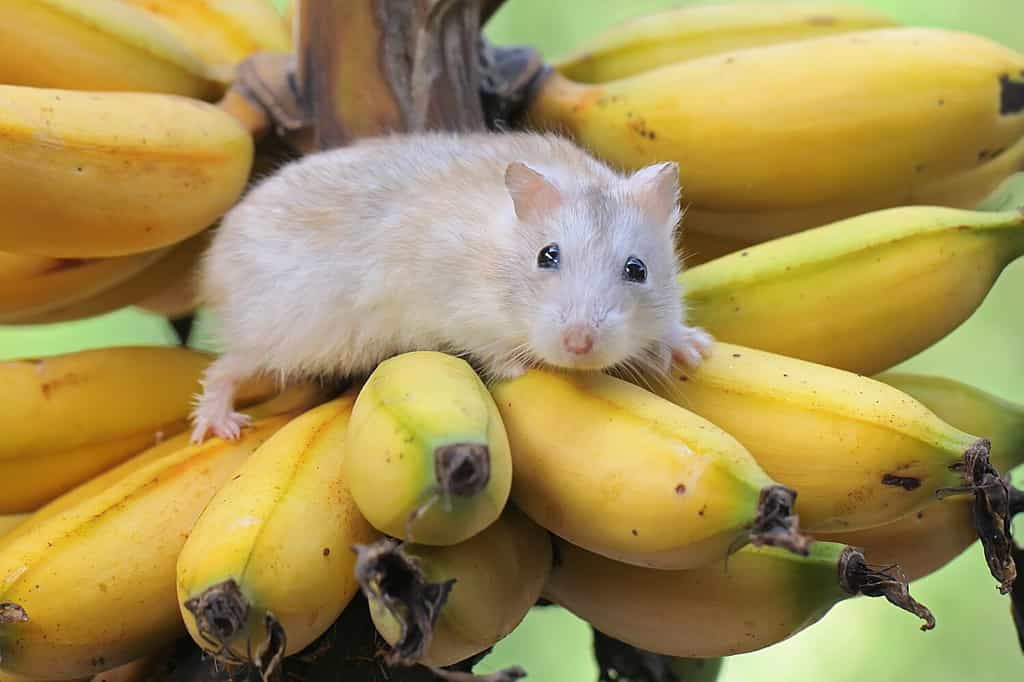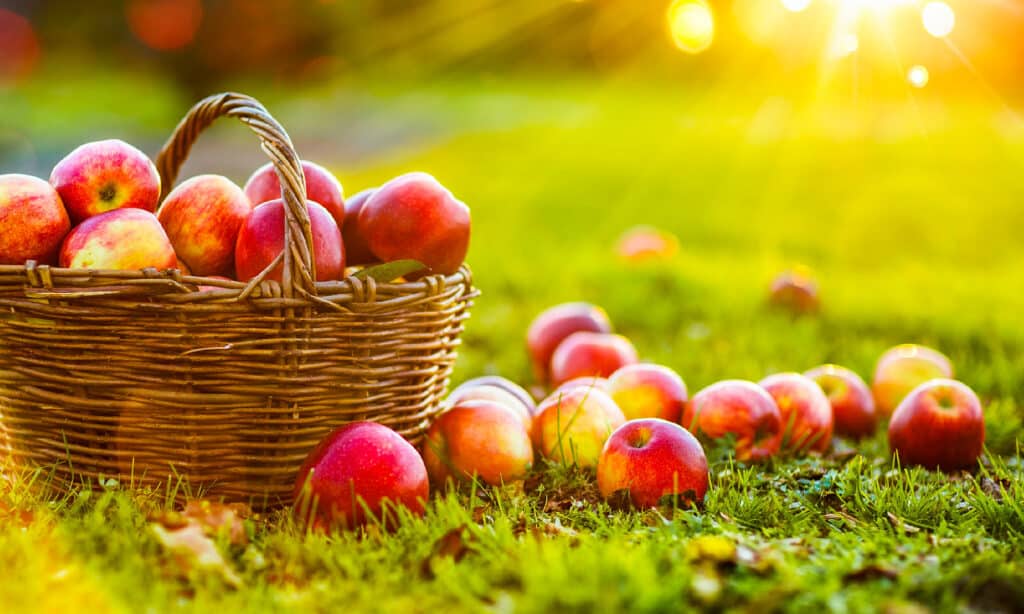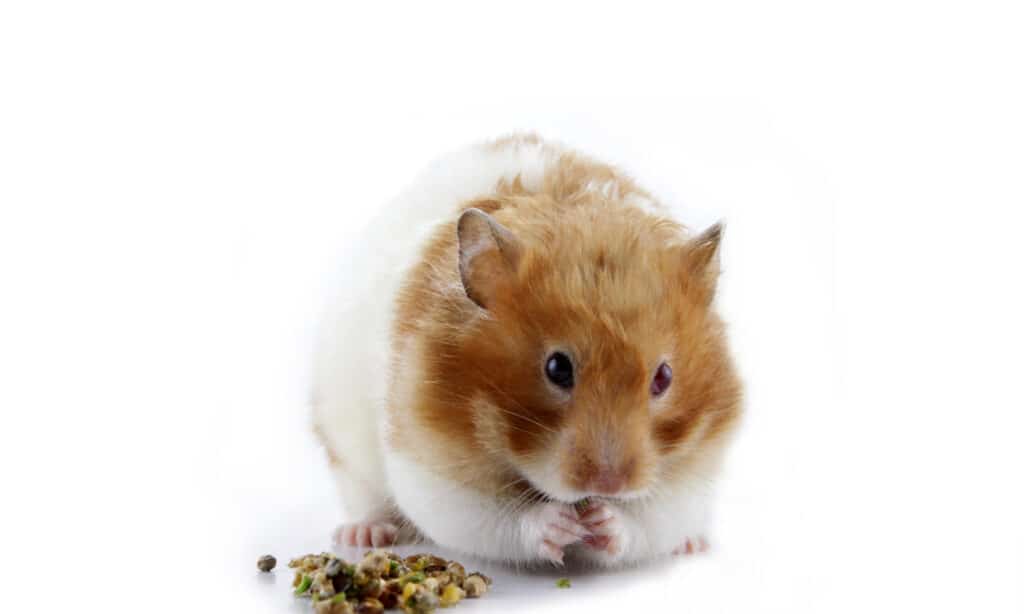If you’re an animal lover considering bringing a pet hamster into your home, it’s essential to understand what constitutes a healthy diet for these tiny creatures. It can be easy to assume that hamsters eat the same things as other common household pets, but this is far from the truth. In this blog post, we will delve into one specific question: Can hamsters eat apples?
Understanding Hamsters and Their Diet

Roborovski hamsters are tiny and full of energy.
©iStock.com/Anyarnia
Hamsters are small rodents that originate from Syria and Greece. There are several species of hamsters, but the most common ones kept as pets are Syrian hamsters and Dwarf hamsters. In the wild, hamsters are omnivores, which means they consume both plants and meat. They often eat seeds, grasses, insects, and even small animals.
In captivity, a domesticated hamster’s diet should consist of high-quality hamster pellets supplemented with fresh fruits, vegetables, and a small amount of protein. However, not all fruits and veggies are safe for your furry friend.
Can Hamsters Eat Fruits?

There are many healthy fruits that a hamster can eat.
©I Wayan Sumatika/Shutterstock.com
Fruits can indeed be part of a hamster’s diet, but moderation is key. Hamsters love the sweet taste of fruit, but too much can lead to obesity and diabetes, especially in Dwarf hamsters. Some safe fruits for hamsters include pears, peaches, bananas, grapes, strawberries, and apples. Always remember to remove any seeds or pits from the fruit, as these can pose a choking hazard or contain harmful substances. Below are some of the fruits that are safe for hamsters.
| Number | Safe Fruit for Hamsters |
|---|---|
| 1 | Apples |
| 2 | Apricots |
| 3 | Bananas |
| 4 | Blueberries |
| 5 | Blackberries |
| 6 | Cantaloupe |
| 7 | Cherries |
| 8 | Cranberries |
| 9 | Dates |
| 10 | Figs |
| 11 | Grapes |
| 12 | Honeydew |
| 13 | Kiwis |
| 14 | Mangos |
| 15 | Nectarines |
| 16 | Papaya |
| 17 | Peaches |
| 18 | Pears |
| 19 | Pineapples |
| 20 | Plums |
| 21 | Raspberries |
| 22 | Strawberries |
| 23 | Watermelon |
Can Hamsters Eat Apples?

The primary diet of Hamsters includes seeds, nuts, grains, fruits, vegetables, and cracked corn.
©iStock.com/Baks
The answer to our main question is yes; hamsters can eat apples. These fruits are low in fat and high in fiber and vitamins A and C, making them a nutritious addition to your hamster’s diet. However, keep in mind that apples should only be given as an occasional treat. A half-teaspoon serving size of apple twice per week is sufficient for a hamster.
Despite their nutritional benefits, apples also pose some risks when fed to hamsters. They contain a high amount of sugar which can lead to obesity and diabetes if consumed in large quantities. Furthermore, apple seeds contain cyanide, which is toxic to hamsters.
How to Prepare Apples for Your Hamster
When preparing an apple for your hamster, start by washing it thoroughly to remove any pesticides. Cut the apple into small pieces that your hamster can easily manage. Remember to remove the seeds before serving the apple to your pet.
It’s advisable to monitor your hamster the first time you offer them an apple. If they show signs of diarrhea or discomfort afterward, it’s best to avoid feeding them apples in the future.
Other Safe Foods for Hamsters

Hamsters can eat apples and many other types of fruits in very small amounts.
©Adrin Shamsudin/Shutterstock.com
Besides apples, there are plenty of other safe foods you can offer your hamster. Other fruits like pears and strawberries are great options. Vegetables such as carrots, cucumbers, broccoli, peas, and spinach are also safe for hamsters. For protein sources, you can offer your furry friend cooked chicken or turkey (without any seasoning), boiled eggs, mealworms, or tiny pieces of cheddar cheese.
However, not all human foods are safe for hamsters. Foods like blue cheese, eggplant, hot peppers, green potato, rhubarb, kidney beans, and any type of deli meat should be avoided as they can harm your pet.
Hamster Cages

Minimum size hamster cage requirements are 40 inches by 20 inches or 775 square feet. Large is better!
©Jennifer Carlsson, CC BY-SA 4.0, via Wikimedia Commons – License
When it comes to housing these adorable little creatures, hamster cages play a crucial role in ensuring their well-being. Contrary to popular belief, the notion that hamsters require small enclosures is nothing but a misconception. In their natural habitat, hamsters are incredibly active creatures, often embarking on journeys of up to 5 miles in a single day. Therefore, confining them to cramped living spaces would be detrimental to their health and happiness.
To truly thrive and lead fulfilling lives, hamsters need ample room to explore and engage with their environment. Experts recommend that hamster cages should have a minimum area of 775 square feet. However, larger enclosures are even more ideal for providing these curious critters with the space they need. By offering an expansive enclosure tailored specifically for them, we can effectively replicate the freedom they experience in the wild.
Moreover, enrichment plays a pivotal role in maintaining our furry friends’ mental stimulation and overall contentment within their cage habitat. Simply providing enough space is not sufficient. Taking steps to ensure engagement through various means is equally important. This involves regularly rearranging the cage layout and introducing different toys that offer both physical activity and mental challenges, such as puzzles or mazes.
Additionally, incorporating elements that mimic natural behaviors is key when caring for a hamster’s emotional well-being. To satisfy their innate desire for digging and burrowing activities, it is essential to provide an area within the enclosure where deep substrate material can be provided—allowing our furry companions to indulge in their favorite burrowing activities.
Are Hamsters Good Pets for Kids?

Being nocturnal, hamsters are not the ideal pet for children.
©Alexruss/Shutterstock.com
Hamsters are not ideal pets for school-age children. When considering whether hamsters make good pets for kids, it is important to take into account their nocturnal nature. Unlike children who are active during the day, hamsters are most active at night and spend much of their daytime hours sleeping. This misalignment in sleep schedules can create challenges when it comes to interacting with the pet.
Interrupting a sleeping hamster during its natural daytime snooze is not ideal for the animal’s well-being. It is crucial to prioritize the treatment of these small creatures by allowing them uninterrupted rest during their designated sleep time. By understanding and respecting their nocturnal habits, we can ensure that our children learn empathy towards animals and develop responsible pet ownership skills.
Moreover, hamster activities at night can be quite noisy. These furry little friends tend to engage in behaviors like scratching, chewing on objects, or running on squeaky exercise wheels while everyone else sleeps peacefully. Such noises may disturb both the child’s sleep quality and overall household tranquility.
Considering these factors, it might be worth exploring alternative companion animals for children who have different activity patterns that align better with a child’s daily routine. Guinea pigs could be a great option as they are diurnal creatures who remain awake throughout most of the day. Their lively presence during daylight hours allows for more interactive moments between children and pets without interfering with either party’s restful periods.
However, regardless of which small animal one chooses as a pet for their child, it remains essential to educate young ones about handling them gently due to their delicate bones that are easily broken.
Conclusion
Understanding your pet’s dietary needs is crucial for their health and well-being. While apples can be a healthy treat for your hamster when served appropriately and in moderation, it’s important to remember that they should only supplement a diet primarily consisting of high-quality pellets.
Before making any major dietary changes for your pet, it’s always best to consult with a vet. Each hamster is unique and may have different dietary needs or restrictions based on their age, breed, and overall health status.
Remember – when it comes to feeding your furry friend, balance and moderation is key! Keep researching and learning about the best ways to take care of your pet, and enjoy the rewarding experience of owning a hamster!
The photo featured at the top of this post is © Lesya Girl/Shutterstock.com
Thank you for reading! Have some feedback for us? Contact the AZ Animals editorial team.






